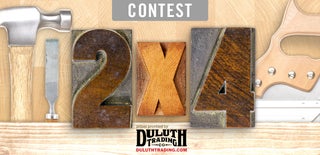Introduction: Baling Fall Leaves
I like to save fall leaves for my garden. I use them for mulch, for bedding in my chicken coop, and for my compost pile. I would bag them in the Fall and save them for use through the summer. The trouble is that they take up a lot of space, and the plastic bags degrade over time, turning into brittle shreds of plastic.
I decided that I needed to save my leaves as compressed bales, like bales of hay or straw. With a little searching, I found a design for a Pine Straw Baler at the East Texas Pine Straw web site of Texas A&M University. The design and publication is downloadable as a PDF file.
Using this as the basis, I made a small baler using scrapwood. I have been going around my neighborhood, raking leaves and compressing them into bales tied with twine. These will be stacked in my garden for later use. We will see how they survive through the year and into Summer.
Note: This 'ible is mainly to show that Fall leaves can be compressed into bales for storage. I couldn't find any other references to baling leaves, and I think this is a pretty nice way to store leaves in a minimum of space. That being said, you are largely on your own for construction of the baler itself. I may add details on construction at a later date, though, once I am satisfied that I can make a good one. Until then, depend on the TAMU PDF file for a measured drawing.
I did make a SketchUp model of the baler, per TAMU's publication, which is at the 3D Warehouse.
Step 1: The Baler
This is it. I have it on a cart so I can drag it around the block to get leaves from other peoples' yards. So far, nobody minds me raking up their leaves.
Step 2: The Door
The door is held in place by a slot that it fits into, and by two nails inserted into drilled holes.
Step 3: Baling Twine
I have some coarse twine. This proved to be too thin, and so I double it up for strength.
Cut enough twine to go up one side, across the top, and down the other side of the baler . . . twice. This twine will be set in the bottom of the baler while leaves are put on top of it.
Secure the twine as shown, so they form a neat 'base' of three crossed strands at the bottom of the baler.
Now the baler is ready for leaves!
Step 4: Adding Leaves
I'm in front of a neighbor's house. I'll rake up all the leaves in the street, and compress them in the baler. I use two rakes to scoop leaves between them. Holding the leaves between two rakes, I can easily carry a load into the top of the baler for release.
When the baler is filled with loose leaves, I tamp them down with the compressor/plunger, and then add more.
As more leaves are added and compressed, there will be too many to fully compress with hand strength alone. I then use the swinging lever arm to apply more pressure on the plunger over the leaves. This gives me more space to add more leaves.
Step 5: Setting the Twine, and the Final Compression
When the baler is 2/3 full after compression, it is time to set the twine for tying.
Release the ends of the twine, and pass them over the leaves (without the plunger), so both ends project out of one slot in the side of the baler. (This makes sense in the picture) Do this for each of the three pieces of baling twine.
When all three pieces of twine are set up like this, there should be a corresponding pattern of crossed twine on the top of the bale as was seen on the bottom.
Now, place the plunger on top of the bale and press down hard. Use the lever arm to compress the leaves as far as they will go, and then tie the lever arm down with a chain or piece of strong cord. This will keep the bale compressed.
Pull the twine tight, and tie the ends to secure the bale.
Step 6: Release the Bale
Release the lever arm carefully, so it doesn't spring back and hit you.
Pull the nails that hold the door in place, and remove the door.
Grab the baling twine at the top of the bale, and pull it up several inches. Then pull the bale out of the baler. You now have a bale of leaves.
It's a bit fragile, compared to a hay bale, and sheds leaves a bit, but it is still surprisingly coherent.
Step 7: Final Comments
I raked up leaves from the street because I had not asked my neighbor if I could take their leaves. I didn't feel right to be actually raking on their front yard. In addition, the leaves on the street won't be mixed with other yard debris like sticks or dog poop.
The single bale took all the leaves in the street area shown here.
Here's a screenshot of the SketchUp model
EDIT: It is now late March, and I have been storing the leaf bales on top of my chicken coop. They have been rained on and snowed on a bit (I live in New Mexico, so there's not much of either). I thought I'd add a follow-up picture to show that the bales have kept their shape over the months.
The leaves are very dry, and they crumble into small fragments when I un-bale them, which is great for my compost bin and for laying down in the henhouse. The chickens don't like to lay eggs on them (they prefer straw). In any case, this does seem to be a good way to compress and store a lot of leaves.

Participated in the
2x4 Contest













